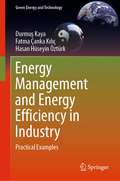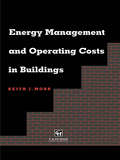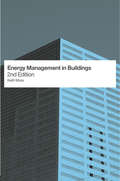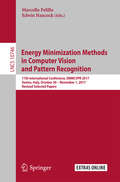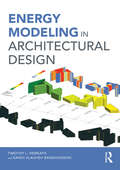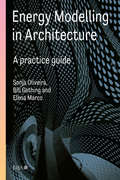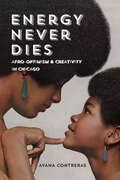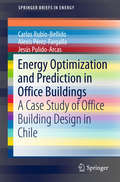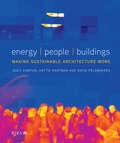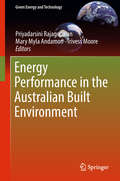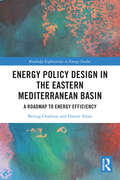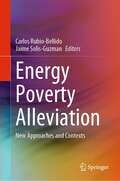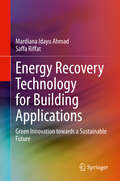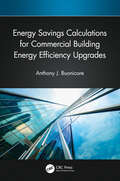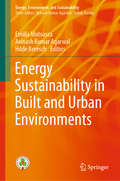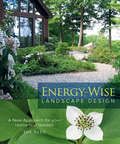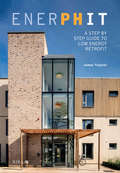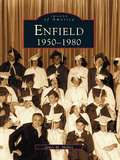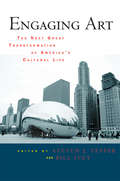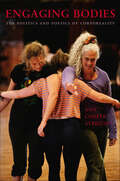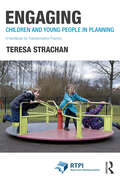- Table View
- List View
Energy Management and Energy Efficiency in Industry: Practical Examples (Green Energy and Technology)
by Durmuş Kaya Fatma Çanka Kılıç Hasan Hüseyin ÖztürkThis book is presented to demonstrate how energy efficiency can be achieved in existing systems or in the design of a new system, as well as a guide for energy savings opportunities. Accordingly, the content of the book has been enriched with many examples applied in the industry. Thus, it is aimed to provide energy savings by successfully managing the energy in the readers’ own businesses. The authors primarily present the necessary measurement techniques and measurement tools to be used for energy saving, as well as how to evaluate the methods that can be used for improvements in systems. The book also provides information on how to calculate the investments to be made for these necessary improvements and the payback periods. The book covers topics such as: • Reducing unit production costs by ensuring the reduction of energy costs, • Efficient and quality energy use, • Meeting market needs while maintaining competitive conditions, • Ensuring the protection of the environment by reducing CO2 and CO emissions with energy saving and energy efficiency, • Ensuring the correct usage of systems by carrying out energy audits. In summary, this book explains how to effectively design energy systems and manage energy to increase energy savings. In addition, the study has been strengthened by giving some case studies and their results in the fields of intensive energy consumption in industry. This book is an ideal resource for practitioners, engineers, researchers, academics, employees and investors in the fields of energy, energy management, energy efficiency and energy saving.
Energy Management and Operating Costs in Buildings
by Keith MossManaging the consumption and conservation of energy in buildings must now become the concern of both building managers and occupants. The provision of lighting, hot water supply, communications, cooking, space heating and cooling accounts for 45 per cent of UK energy consumption.Energy Management and Operating Costs in Buildings introduces the reader to the principles of managing and conserving energy consumpton in buildings people use for work or leisure. Energy consumption is considered for the provision of space heating, hot water, supply ventilation and air conditioning. The author introduces the use of standard performance indicators and energy consumption yardsticks, and discusses the use and application of degree days.
Energy Management in Buildings
by Keith MossManaging the consumption and conservation of energy in buildings is the concern of both building managers and occupants and this use accounts for about half of UK energy consumption. The need to manage this has been given new emphasis by the introduction of the Climate Change Levy. Energy Management in Buildings introduces students and energy managers to the principles of managing and conserving energy consumpton in buildings people use for work or leisure. Energy consumption is considered for the provision of space heating, hot water, supply ventilation and air conditioning. The author introduces the use of standard performance indicators and energy consumption yardsticks and discusses the use and application of degree days. This second edition includes two new chapters on current regulations and environmental impact of building services. It closely follows recent bench marking published by CIBSE and the Defra energy efficiency Best Practice Programme and covers unit 18 in the new HND in building services engineering.
Energy Minimization Methods in Computer Vision and Pattern Recognition: Second International Workshop, Emmcvpr'99, York, Uk, July 26-29, 1999, Proceedings (Lecture Notes in Computer Science #1654)
by Marcello Pelillo Edwin HancockThis volume constitutes the refereed proceedings of the 11th International Conference on Energy Minimization Methods in Computer Vision and Pattern Recognition, EMMCVPR 2017, held in Venice, Italy, in October/November 2017. The 37 revised full papers were carefully reviewed and selected from 51 submissions. The papers are organized in topical sections on Clustering and Quantum Methods; Motion and Tracking; Image Processing and Segmentation; Color, Shading and Reflectance of Light; Propagation and Time-evolution; and Inference, Labeling, and Relaxation.
Energy Modeling in Architectural Design
by Timothy L. Hemsath Kaveh Alagheh BandhosseiniEnergy Modeling in Architectural Design demonstrates how design elements can lead to energy savings, to help you reduce the energy footprint of your buildings. In addition to identifying climate opportunities, you#65533;ll also learn fundamental passive design elements for software-agnostic energy modeling of your projects from conception. Using parametric models and testing each element during design will lead you to create beautiful and high-performance buildings. Illustrated with more than 100 color images, this book also includes a pattern guide for high-performance buildings, discusses energy and daylighting optimization, and has a glossary for easy reference.
Energy Modelling in Architecture: A practice guide
by Sonja Oliviera Bill Gething Elena MarcoThis book offers a practical guide to embedding energy modelling in architectural practice. With expert contributions from leading architects and practices, this book illustrates architects’ approaches to learning, sharing and integrating energy modelling across a range of design projects, in both small and large firms in the UK and internationally. Discussing the practical and business implications of embedding energy modelling in practice, this is an essential manual for the energy-literate architect.
Energy Never Dies: Afro-Optimism and Creativity in Chicago
by Ayana ContrerasFrom Afro Sheen to Theaster Gates and from Soul Train to Chance the Rapper, Black Chicago draws sustenance from a culture rooted in self-determination, aspiration, and hustle. In Energy Never Dies, Ayana Contreras embarks on a journey to share the implausible success stories and breathtaking achievements of Black Chicago's artists and entrepreneurs. Past and present generations speak with one another, maintaining a vital connection to a beautiful narrative of Black triumph and empowerment that still inspires creativity and pride. Contreras weaves a hidden history from these true stories and the magic released by undervalued cultural artifacts. As she does, the idea that the improbable is always possible emerges as an indestructible Afro-Optimism that binds a people together. Passionate and enlightening, Energy Never Dies uses the power of storytelling to show how optimism and courage fuel the dreams of Black Chicago.
Energy Optimization and Prediction in Office Buildings: A Case Study Of Office Building Design In Chile (SpringerBriefs in Energy)
by Carlos Rubio-Bellido Alexis Pérez-Fargallo Jesús Pulido-ArcasThis book explains how energy demand and energy consumption in new buildings can be predicted and how these aspects and the resulting CO2 emissions can be reduced. It is based upon the authors’ extensive research into the design and energy optimization of office buildings in Chile. The authors first introduce a calculation procedure that can be used for the optimization of energy parameters in office buildings, and to predict how a changing climate may affect energy demand. The prediction of energy demand, consumption and CO2 emissions is demonstrated by solving simple equations using the example of Chilean buildings, and the findings are subsequently applied to buildings around the globe.An optimization process based on Artificial Neural Networks is discussed in detail, which predicts heating and cooling energy demands, energy consumption and CO2 emissions. Taken together, these processes will show readers how to reduce energy demand, consumption and CO2 emissions associated with office buildings in the future. Readers will gain an advanced understanding of energy use in buildings and how it can be reduced.
Energy, People, Buildings: Making sustainable architecture work
by Judit Kimpian Sofie Pelsmakers Hattie HartmanEnergy performance feedback is an essential tool in addressing the current climate crisis. However, this is not simply another theoretical text about energy performance in buildings. This book is for anyone who wants to better understand how energy is used in buildings, and how to drive down operational energy use – whether you’re an architect, student, client, building services engineer, contractor, building operator or other stakeholder. Focusing on evidence from feedback on buildings in use, it explains what it takes to get them to perform as expected, as well as the reasons why they often fail. Energy, People, Buildings draws extensively on the findings of studies, UK government-funded building performance evaluations and on original research into seven case studies from across the UK and abroad that have achieved exemplary energy use through building performance feedback. Providing a clear roadmap to understanding aspects that impact building users’ comfort and satisfaction, it also outlines the factors behind energy use and how to track it across the life of a project to ensure that your building performs as intended. Case studies include: the Everyman Theatre, Liverpool; Rocky Mountain Institute Innovation Center, Colorado; and Carrowbreck Meadow, Norwich. Featured architects: AHMM, AHR, Architype, Hamson Barron Smith, Haworth Tompkins, Henning Larsen Architects and ZGF Architects.
Energy Performance in the Australian Built Environment (Green Energy and Technology)
by Priyadarsini Rajagopalan Mary Myla Andamon Trivess MooreThis book examines energy efficiency in the Australian built environment and presents current developments with a particular focus on the temperate setting of Victoria state. It is divided into four main parts discussing policies, climate, and carbon footprint and presenting case studies on the energy performance and indoor environmental quality of various building types. The book is intended for readers wanting to understand the various policies related to different buildings types and their energy performance.
Energy Policy Design in the Eastern Mediterranean Basin: A Roadmap to Energy Efficiency (Routledge Explorations in Energy Studies)
by Bertug Ozarisoy Hasim AltanThis book explores energy consumption and thermal comfort in the social housing sector in the Eastern Mediterranean basin. This book presents a novel methodological framework for the optimisation of post-war social housing developments in the Eastern Mediterranean climate. The authors draw on semi-structured interviews to present evidence on in situ thermal sensation and provide the results of walk-through and walk-in thermographic surveys to highlight building-fabric performance and highlight anomalies in the building envelopes. The authors go on to show how this data-informed retrofit design solution can be applied to reduce household energy consumption, increase awareness of domestic energy use and inform effective policymaking decisions in energy use in the Eastern Mediterranean basin, including the development of Energy Performance Certificate schemes. This book will be of great interest to students and scholars of energy policy, energy efficiency and planning. It will also assist architects, building engineers and other practitioners in closing the gap between the current understanding and the actual performance of existing residential building stocks in the Eastern Mediterranean basin.
Energy Poverty Alleviation: New Approaches and Contexts
by Carlos Rubio-Bellido Jaime Solis-GuzmanThis book presents research on energy poverty alleviation, approaching the complex phenomenon topic holistically and with heterogeneity. It includes contributions from research teams studying the topic at a national, regional and local levels worldwide. The book is divided in two main blocks. The first part, New Approaches, involves novel assessments and concepts from a global and multidisciplinary point of view. The second part, Contexts, offers new theoretical diagnoses focused on case studies of different scales from around the world, and concepts for future trends. Energy Poverty Alleviation will be of interest to policy makers, stakeholders, academics and researchers with knowledge in the energy poverty field.
Energy Recovery Technology for Building Applications: Green Innovation towards a Sustainable Future
by Mardiana Idayu Ahmad Saffa RiffatThis book discusses energy recovery technology, a green innovation that can be used in buildings. This technology reduces energy consumption in buildings and provides energy savings to conventional mechanical ventilation systems. Divided into eight chapters, the book provides in-depth technical information, state-of-the-art research, and latest developments in the energy recovery technology field. Case-studies describe worldwide applications of energy recovery technology and its integrated system for building services. This book will be used as a general and technical reference book for students, engineers, professionals, practitioners, scientists, and researchers seeking to reduce energy consumption of buildings in various climatic conditions.Presents an overview of energy consumption scenarios in buildings and the needs for energy-efficient technologies at regional and global levels;Explains models and methods of energy recovery technology performance evaluation;Inspires further research into energy recovery technology for building applications.
Energy Savings Calculations for Commercial Building Energy Efficiency Upgrades
by Anthony J. BuonicoreCode-compliant building materials and equipment will typically have a lower initial cost; however, the lifetime energy savings of the high efficiency equipment will often justify the upfront cost premium and result in a more cost-effective solution. Energy Savings Calculations for Commercial Building Energy Efficiency Upgrades assists energy professionals, contractors, building owners, and managers in developing energy savings estimates that can facilitate a quick assessment of the potential energy savings that might be realized when replacing existing building components with the highest efficiency equipment. It also provides algorithms to estimate greenhouse gas emission reductions that may be achieved by building energy efficiency upgrades and the impact these upgrades can have on building electrification-decarbonization projects. This book: Focuses on the development of energy savings estimates based upon a whole building’s energy consumption and the energy consumption associated with building end-uses such as space heating, space cooling, ventilation, lighting, and so forth. Includes over 70 illustrative examples using algorithms to demonstrate how energy savings and greenhouse gas emission reductions may be estimated utilizing different strategies and equipment.
Energy Sustainability in Built and Urban Environments (Energy, Environment, and Sustainability)
by Emilia Motoasca Avinash Kumar Agarwal Hilde BreeschThis book covers different aspects of energy sustainability in residential buildings and neighborhoods, starting from the construction and design aspects, and moving on to HVAC systems and lighting, and the applications, harvesting, use and storage of renewable energy. The volume focuses on smart and sustainable use of energy, discussing both the technological advancements and the economic, social and environmental impacts. Novel approaches to recycling of waste and materials in the context of residential buildings are also presented. This volume will be of interest to researchers and policy makers working in the fields of renewable energy, sustainable design and city planning.
Energy Sustainability in Built and Urban Environments (Energy, Environment, and Sustainability)
by Emilia Motoasca Avinash Kumar Agarwal Hilde BreeschThis book covers different aspects of energy sustainability in residential buildings and neighborhoods, starting from the construction and design aspects, and moving on to HVAC systems and lighting, and the applications, harvesting, use and storage of renewable energy. The volume focuses on smart and sustainable use of energy, discussing both the technological advancements and the economic, social and environmental impacts. Novel approaches to recycling of waste and materials in the context of residential buildings are also presented. This volume will be of interest to researchers and policy makers working in the fields of renewable energy, sustainable design and city planning.
Energy-Sustainable Advanced Materials
by Mark Alston Timothy N. LambertThis book highlights progress towards the capture, storage, and utilization of energy through the development of advanced materials and systems based on abundant elements, materials, and commodities. Energy is critical to human sustainability and a global-scale deployment of renewable energy systems will be required. Hence, the chapters integrate the fundamental aspects that enable the technical advancements in detail, along with an emphasis on the need for highly sustainable materials to enable real impact for humankind: To determine innovation of energy capture and storage through characterizations of materials in areas of electrical generation and electrical storage systems; To demonstrate better performance, economic and environmental advantages than the current state of the art; To define new chemistries and materials for innovations in energy density design through lower operational temperatures, improve safety, expanding operational voltage, battery durability lifetimes, and reduce system costs. Advances critical technical and commercial objectives for novel high energy density materials;Evaluates operational material models for optimizing energy capture that are integrated by configurations as a system; Illustrates utilization of material life cycle assessment for high energy outputs generators for sustainable materials.
Energy-Wise Landscape Design
by Sue ReedResidential consumption represents nearly one quarter of North America's total energy use and the average homeowner spends thousands of dollars a year on power bills. To help alleviate this problem, Energy-Wise Landscape Design presents hundreds of practical ways everyone can save money, time, and effort while making their landscapes more environmentally healthy, ecologically rich, and energy efficient.Combining general guidelines with tips, techniques, and actions, this fully illustrated guide explains the many opportunities our landscapes provide for conserving energy. Readers will learn how to: Lower a home's heating and cooling costs Minimize fuel used in landscape construction, maintenance, and everyday use Choose landscape products and materials with lower embedded energy costs Make a positive difference without a major investment or change in lifestyle Intended for homeowners, gardeners, landscape professionals, and students, the design ideas in this book will work in every type of setting--large or small, hilly or flat, urban or rural. Written in non-scientific language with clear explanations and an easy conversational style, Energy-Wise Landscape Design is an essential resource for everyone who wants to shrink their energy footprint while enhancing their property and adding value to their home.Sue Reed is a registered landscape architect and a specialist in ecological landscape design who has helped hundreds of homeowners create comfortable, livable, and beautiful landscapes that save energy. She is also an experienced writer and teacher whose work specifically focuses on environmentally sound, energy-efficient, and sustainable landscape design.
EnerPHit: A Step by Step Guide to Low Energy Retrofit
by James TraynorIn order to meet UK Carbon reduction commitments for 2020 and 2050 building owners will be required to upgrade their buildings to meet an increasingly stringent set of energy performance requirements. In the absence of any clear advice from UK Government on how this can be achieved, the EnerPHit standard offers a very clear methodology. This is a practical guide that gives architects the tools to retrofit buildings to the highest EnerPHit standard. It equips the reader with the key information on EnerPHit (as the most effective benchmark for performance), the practical know-how and tips to ensure effective retrofit throughout all Plan of Work stages of a project to the EnerPHit standard. Backed with real-life case studies, it enables you to understand how to achieve successful outcomes tailored to suit available budgets and programmes.
Enfant Terrible!: Jerry Lewis in American Film
by Jerry LewisThe one thing everybody knows about Jerry Lewis is that he is beloved by the French, those incomprehensible hedonistic strangers across the sea. The French understand him, while in the U.S. he is at best a riddle, not one of us. Lewis is someone we take profound pleasure in excluding, if not ridiculing. Enfant Terrible! Jerry Lewis in American Film is the first comprehensive collection devoted to one of the most controversial and accomplished figures in twentieth-century American cinema. A veteran of virtually every form of show business, Lewis's performances onscreen and the motion pictures he has directed reveal significant filmmaking talents, and show him to be what he has called himself, a "total filmmaker." Yet his work has been frequently derided by American critics. This book challenges that easy reading by taking a more careful look at Lewis's considerable body of work onscreen in 16 diverse and penetrating essays. Turning to such films asThe Nutty Professor, The Ladies Man, The King of Comedy, The Delicate Delinquent, Living It Up, The Errand Boy, The Disorderly Orderly, Arizona Dream, and The Geisha Boy, the contributors address topics ranging from Lewis's on- and offscreen performances, the representations of disability in his films, and the European obsession with Lewis, to his relationship with Dean Martin and Lewis's masculinity. Far from an out of control hysteric, Enfant Terrible! instead reveals Jerry Lewis to be a meticulous master of performance with a keen sense of American culture and the contemporary world. Contributors include: Mikita Brottman, Scott Bukatman, David Desser, Leslie A. Fiedler, Craig Fischer, Lucy Fischer, Krin Gabbard, Barry Keith Grant, Andrew Horton, Susan Hunt, Frank Krutnik, Marcia Landy, Peter Lehman, Shawn Levy, Dana Polan, Murray Pomerance, and J. P. Telotte.
Enfield: 1950-1980
by James M. MalleyIn the past half-century, Enfield has undergone a transformation from a rural mill-and-farming town of fifteen thousand to a substantial suburban community of forty-five thousand. Located in the north central part of the state on the eastern side of the Connecticut River, the town once known as the Carpet City began to change when the carpet industry moved parts of its operation south and Interstate 91 was built, bringing in new businesses and new residents.Enfield: 1950-1980 traces the changing landscape of Thompsonville, Enfield, and North Thompsonville through the carpet-making days to the town's recent past. Exceptional photographs depict major highway construction and the development of the regional mall district, the destructive forces of the 1955 flood and of fires throughout the years, and the unique leaders, businesses, and events that have shaped the town of today.
Engaged Journalism: Connecting with Digitally Empowered News Audiences
by Jake BatsellExplores the changing relationship between news producers and audiences and the methods journalists can use to secure the attention of news consumers.
Engaging Art: The Next Great Transformation of America's Cultural Life
by Steven J. Tepper Bill IveyEngaging Art explores what it means to participate in the arts in contemporary society – from museum attendance to music downloading. Drawing on the perspectives of experts from diverse fields (including Princeton scholars Robert Wuthnow and Paul DiMaggio; Barry Schwartz, author of The Paradox of Choice; and MIT scholars Henry Jenkins and Mark Schuster), this volume analyzes key trends involving technology, audience demographics, religion, and the rise of "do-it-yourself" participatory culture. Commissioned by The Wallace Foundation and independently carried out by the Curb Center at Vanderbilt University, Engaging Art offers a new framework for understanding the momentous changes impacting America’s cultural life over the past fifty years. This volume offers suggestive glimpses into the character and consequence of a new engagement with old-fashioned participation in the arts. The authors in this volume hint at a bright future for art and citizen art making. They argue that if we center a new commitment to arts participation in everyday art making, creativity, and quality of life, we will not only restore the lifelong pleasure of homemade art, but will likely seed a new generation of enthusiasts who will support America’s signature nonprofit cultural institutions well into the future.
Engaging Bodies: The Politics and Poetics of Corporeality
by Ann Cooper AlbrightWinner of the Selma Jeanne Cohen Prize in Dance Aesthetics (2014)For twenty-five years, Ann Cooper Albright has been exploring the intersection of cultural representation and somatic identity in dance. For Albright, dancing is a physical inquiry, a way of experiencing and participating in the world, and her writing reflects an interdisciplinary approach to seeing and thinking about dance. In her engagement as both a dancer and a scholar, Albright draws on her kinesthetic sensibilities as well as her intellectual knowledge to articulate how movement creates meaning. Throughout Engaging Bodies movement and ideas lean on one another to produce a critical theory anchored in the material reality of dancing bodies. This blend of cultural theory and personal circumstance will be useful and inspiring for emerging scholars and dancers looking for a model of writing about dance that thrives on the interconnectedness of watching and doing, gesture and thought.Hardcover is un-jacketed.
Engaging Children and Young People in Planning: A Handbook for Transformative Practice (ISSN)
by Teresa StrachanEngaging Children and Young People in Planning places planners’ skills for engagement with children and young people centre stage by discussing several projects delivered or supported by planning students to young people in the Northeast of England. Urban or town and country planning is a largely unfamiliar concept to children and young people. Moreover, in England, the environment in which young people live, play and go to school is shaped by a local planning process which lacks their input. This book explores the nature of the gap between that planning process and the voice of the younger members of the community, as well as the barriers that impede this engagement. It highlights why an engagement process is beneficial for those young people, for the wider community and for the planning process itself. At a time when our relationship with and impact on, the environment is being re-examined, this book challenges the planning professional to identify, develop and reflect upon the engagement skills that will help to transform planning into a more inclusive practice. It will be of use to scholars and practitioners in urban planning, community planning, engagement and children’s rights, whilst supporting their academic and professional development pathways.
